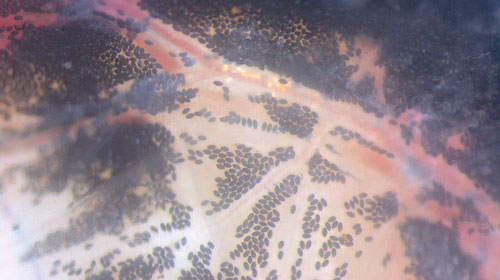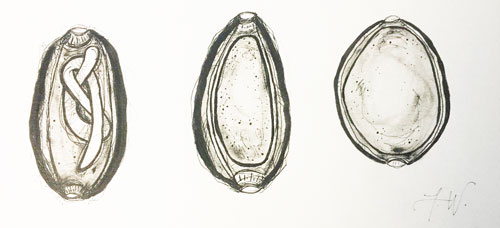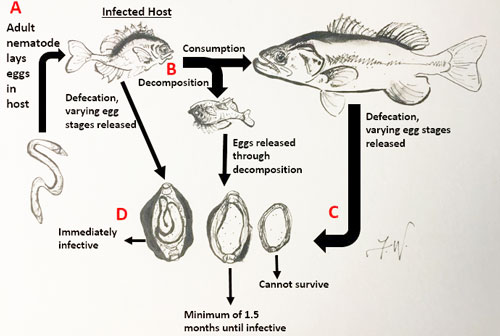common name: fish nematode
scientific name: Huffmanela spp. (Enoplea: Trichinellida: Trichosomoididae)
Introduction - Distribution - Life Cycle - Symptoms - Hosts - Continuing Research - Selected References
Introduction (Back to Top)
Huffmanela (Figure 1) is a genus of parasitic nematodes in the family Trichosomoididae.
Huffmanela species infest only one freshwater fish species and a small number of saltwater fishes. They commonly affect many tissues in particular the swim bladder, gut mucosa, skin, and musculature (Carballo and Navone 2007).
Figure 1. Egg stage of Huffmanela huffmani (Host unknown). Photograph by David Huffman.
Distribution (Back to Top)
Approximately 20 species of Huffmanela have been found and described, most of which have been recovered in the egg stage (Justine and Iwaki 2014). Huffmanela spp. are found mostly in marine waters. One exception is Huffmanela huffmani, which is found in the swimbladder of the freshwater species Amblopites rupestris, Micropterus salmoides, and Lepomis spp. from an upper spring run in central Texas (Moravec 1987). Records of Huffmanela species have been from the south west Pacific Ocean near New Caledonia (Justine 2007), the Sea of Japan (Moravec et al. 1998), the Pacific coast of Mexico (Moravec and Fajer-Avila 2000), the Ligurian Sea in northern Italy (Moravec and Garibaldi 2000), the North Patagonian Gulfs in Argentina (Carballo and Navone 2007), the Pacific Ocean near Vancouver (Moravec et a. 2005), and the northwest Gulf of Mexico off the coast of Texas (Ruiz and Bullard 2013).
Life Cycle and Biology (Back to Top)
Eggs: Huffmanela eggs are small, measuring approximately 48 to 113 µm in length, and 20 to 54 µm in width (Justine 2011, Ruiz and Bullard 2013). They are typically oval or spindle shaped (Figure 3) (Zd'árská et al. 2001, Ruiz and Bullard 2013). While some eggs have a smooth surface (Ruiz and Bullard 2013), others have a layer of filamentous hairs (Justine 2011). Nematode eggs in this genus can vary in color. For example, young eggs of Huffmanela plectropomi are typically yellow and as the eggs age they become a darker brown, until becoming black (Justine 2011) as seen in Figure 2. Similarly, Huffmanela markgracei eggs range from clear to amber brown (Ruiz and Bullard 2013). The eggs often have layers, including a vitelline layer, chitinous layer, and lipid layer (Zd'árská et al. 2001). While in the egg stage the larvae become fully developed and then emerge as adults (Moravec 1987). When Huffmanela is noticed, it is usually because the flesh that it infects has become apparent due to the darkening of tissue in or around the infected organ (Huffman, 2019).
Figure 2. Eggs of Huffmanela huffmani, infesting the kidney of Lepomis auratus. Photograph by David Huffman.
Figure 3. Three egg stages of a Huffmanela nematode. The far right egg is recently laid, and the eggs develop from right to left. The middle egg is unlarvated, but has a fully developed shell. The left egg has a fully larvated nematode ready to emerge. Figure by Fauve Wilson.
Adults: The genus Huffmanela is comprised of nematodes that have a worm-like shape in the adult stage. Both male and female Huffmanela huffmani have a long and very narrow body shape, ranging from 4.69 mm to 7.51 mm as described by Moravec (1987). The width of Huffmanela bodies range from 0.024 mm to 0.030 mm (Moravec 1987). Of adults studied, they have a rather smooth body, sometimes with dense but fine striation on both ends of the worm shaped body (Huffman and Moravec 1988).
Little is known about Huffmanela life cycles. Only six species of Huffmanela are described as adults, and therefore most Huffmanela species are described only from the eggs. Huffmanela nematodes deposit their eggs in organs that are species-specific to each host (Worsham et al. 2015). No one has been able to successfully hatch Huffmanela eggs inside of a host in a laboratory setting. Either digestion by another animal or natural decomposition of the host is necessary for the eggs to come into the environment.
The adult must lay eggs in its host, and those eggs must stay within the host long enough to transition to post infection. Eggs are released from their host after the host dies and releases the eggs through decomposition, or the host is consumed by another fish, that then defecates the eggs that were not digested indicating they have adequately developed protective shells (Figure 4 section B). Then the eggs fall into sediment (Figure 4 section C). The developed eggs take different pathways until they are infective. The young eggs that are not fully developed cannot survive past this stage. Eggs without developed larvae that have fully developed shells can survive either in the environment or in the gastrointestinal tract of the new host. As shown in the diagram, the fully larval eggs are already infective to food that potential hosts may consume, as shown in section D of Figure 4 (Moravec 1987). The Huffmanela life cycle could be completed within 12 months, but may take as long as 36 months (Moravec 1987).
Figure 4. Steps in the life cycle of the species Huffmanela huffmani, the only fresh water Huffmanela species known. This figure is based off of the first lab-based life cycle in the genus Huffmanela. Figure not to scale. Figure by Fauve Wilson.
Hosts (Back to Top)
The genus Huffmanela infects many different tissues of some sharks and bony fishes. Huffmanela can affect many areas in fish and eel bodies, including the skin, oral cavity, gill openings, spinal column, bone, muscles, and swim bladder (Table 1) (Huffman and Moravec 1988, Moravec et al. 1998, Moravec and Fajer-Avila 2000, Moravec and Garibaldi 2000, Justine 2004, Justine 2005, Justine 2007, Justine 2011, Ruiz and Bullard 2013, Justine and Iwaki 2014).
Table 1. Comprehensive recorded hosts of Huffmanela nematodes. The nematode species, host species, location of the host parasitized by the nematodes, and the life stage of the nematodes is included.
Huffmanela species |
Host |
Location parasitized |
Parasite life stage described |
Huffmanela markgracei |
Rhizoprionodon |
Buccal cavity |
Eggs |
Huffmanela huffmani |
Lepomis cyanellus (green sunfish), Lepomis macrochirus (bluegill), and Lepomis punctatus (spotted sunfish) |
Swimbladder
|
Eggs and Adults |
Huffmanela paronai |
Xiphias gladius (swordfish) |
Skin |
Eggs |
Huffmanela lata |
Carcharhinus amblyrhynchos (grey reef shark) |
Gill opening |
Eggs |
Huffmanela mexicana |
Sphoeroides annulatus (bullseye puffer fish) |
Swimbladder |
Eggs |
Huffmanela plectropomi |
Plectropomus leopardus (coral grouper) |
Skin |
Eggs |
Huffmanela ossicola |
Bodianus loxozonus, Bodianus busellatus, and Bodianus perdition (hogfishes) |
Spinal cord |
Eggs |
Huffmanela shikokuensis |
Stephanolepis cirrhifer (thread-sail filefish) |
Muscle |
Eggs |
Huffmanela balista |
Abalistes stellatus (triggerfish) |
Swimbladder |
Eggs and Adults |
Huffmanela filamentosa |
Gymnocranius grandoculis (blue-lined large-eye bream) |
Gill opening |
Eggs |
Huffmanela branchialis |
Nemipterus furcosus (fork-tailed threadfin bream) |
Gill opening |
Eggs |
Huffmanela hamo |
Muraenesox cinereus (pike conger) |
Muscle |
Eggs |
Huffmanela japonica |
Upeneus bensai (Japanese goatfish) |
Skin |
Eggs |
Huffmanela longa |
Gymnocranius grandoculis (blue-lined large-eye bream) |
Swimbladder |
Eggs |
Huffmanela moraveci |
Odontesthes smitti, Odontesthes nigricans (silversides) |
Fins and Gill Opening |
Eggs and Adults |
Huffmanela carcharini |
Carcharinus melanopterus (blacktip reef shark) |
Skin and Gill Mucosa |
Eggs |
Huffmanela canadensis |
Sebastes spp. (rockfish) |
Skin |
Eggs and Adults |
Continuing Research (Back to Top)
There is not much information on species in this genus. Most species of Huffmanela have only been described from the egg stage (as noted in Table 1). Aquatic species, particularly the marine species, are difficult to study. Finding the host aquatic species that are infected, collecting, and maintaining the host is difficult to do because maintaining and replicating aquatic environments is challenging.
Selected References (Back to Top)
- Carballo MC, Navone GT. 2007. A new Huffmanela species (Nematoda: Trichosomoididae) parasitizing atherinid fishes in North Patagonian Gulfs, Argentina. Journal of Parasitology 93: 377-382.
- Huffman DG, Moravec F. 1988. First description of adult Huffmanela huffmani Moravec, 1987 (Nematoda: Trichosomoididae) from the swimbladder of centrarchid fishes of the upper San Marcos River, central Texas. Folia Parasitologica 35: 227-234.
- Huffman DG. Personal communication, 26 July 2019.
- Justine J. 2004. Three new species of Huffmanela Moravec, 1987 (Nematoda: Trichosomoididae) from the gills of marine fish off New Caledonia. Systematic Parasitology 59: 29-37.
- Justine J. 2005. Huffmanela lata n. sp. (Nematoda: Trichosomoididae: Huffmanelinae) from the shark Carcharhinus amblyrhynchos (Elasmobranchii: Carcharhinidae) off New Caledonia. Systematic Parasitology 61: 181-184.
- Justine J. 2007. Huffmanela spp. (Nematoda, Trichosomoididae) parasites in coral reef fishes off New Caledonia, with descriptions of H. balista n. sp. and H. longa n. sp. Zootaxa 1628: 23-41.
- Justine J. 2011. Huffmanela plectropomi n. sp. (Nematoda: Trichosomoididae: Huffmanelinae) from the coral grouper Plectropomus leopardus (Lacépède) off New Caledonia. Systematic Parasitology 79: 139-143.
- Justine J, Iwaki T. 2014. Huffmanela hamo sp. n. (Nematoda: Trichosomoididae: Huffmanelinae) from the dagger-tooth pike conger Muraenesox cinereus off Japan. Folia Parasitologica 61: 267-271.
- Moravec F, B Koudela, K Ogawa, K Nagasawa. 1998. Two new Huffmanela species, H. japonica n. sp. and H. shikokuensis n. sp. (Nematoda: Trichosomoididae), from marine fishes in Japan. The Journal of Parasitology 84: 589-593.
- Moravec F, Fajer-Avila E. 2000. Huffmanela mexicana n. sp. (Nematoda: Trichosomoididae) from the marine fishes Sphoeroides annulatus in Mexico. Journal of Parasitology 86: 1229-1231.
- Moravec F, Garibaldi F. 2000. Huffmanela paronai sp. n. (Nematoda: Trichosomoididae), a new parasite from the skin of swordfish Xiphias gladius in the Ligurian Sea (Western Mediterranean). Folia Parasitologica 47: 309-313.
- Moravec FE, GA Conboy, J Speare. 2005. A new trichosomoidid from the skin of Sebastes spp. (Pisces) from British Columbia, Canada. Journal of Parasitology 91: 411-414.
- Ruiz CF, Bullard SA. 2013. Huffmanela markgracei sp. n. (Nematoda: Trichosomoididae)
from buccal cavity of Atlantic sharpnose shark, Rhizoprionodon terraenovae (Carcharhiniformes: Carcharhinidae), in the northwestern Gulf of Mexico off Texas. Folia Parasitologica 60: 353-358. - Zd'árská Z, Huffman DG, Moravec F, Nebesárová J. 2001. Egg shell ultrastructure of the fish nematode Huffmanela huffmani (Trichosomoididae). Folia Parasitologica 48: 231-234.



